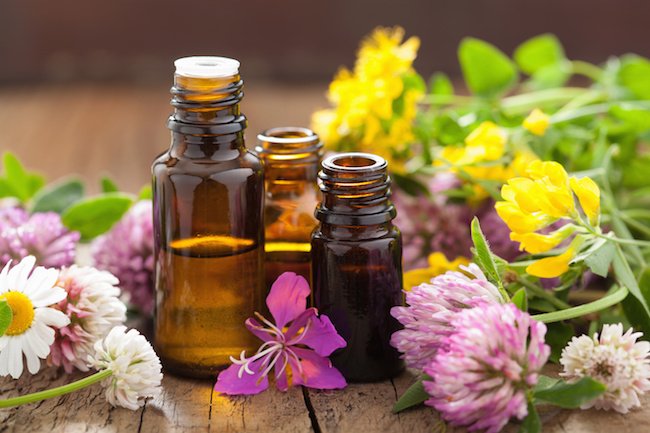The Essential Oils that can Naturally Help Heal Brain Injuries

It’s quite true that aromatherapy can penetrate deeper into the tissues than many other healing modalities. Because they are inhaled through the nose, essential oils will efficiently pass through the blood brain barrier in the area surrounding the olfactory nerve. This makes them very serious contenders as natural healers for brain injuries and more.
A true blood-brain barrier is 8 cells in thickness. The number of cells which constitute the layer around the olfactory nerve is only 4 to 5 cells thick. Hence, it is very easy for the oils to pass straight through to the brain when breathed in through the nose.
“When essential oils are inhaled through the nose, tiny nerves send an immediate signal to the brain and go straight to work on the systems that moderate our minds and bodies. Inhalation can be the most direct delivery method of these incredibly nurturing components in essential oils, since the chemical messengers in the nasal cavity have direct access to the brain.” [1]
This quality of essential oils is a critical one where it concerns brain injuries. Every injury in the body requires good circulation to enhance healing. Ideal circulation provides plenty of oxygen and nutriments to the injury site as well as removes carbon dioxide, waste products, and toxic residues.
Essential oils that promote circulation, particularly in brain tissue, can greatly accelerate the healing process of injuries in the head. Not only will the deeply penetrating oils increase circulation, some of them have the right chemical constituents that can assist in the repair of injured brain tissue.
Related: 10 Essential Oils for Detoxing and Boosting Immunity

The Essential Oil of Frankincense
If there is one essential oil that is particularly well indicated for brain injuries, it is frankincence. Frankincense has a number of unique qualities that make it exceptionally potent in the treatment of specific types of brain damage. For instance, it has the capacity to increase the oxygenation of the blood going to the brain which will in turn help with the absorption of oxygen.
What’s more, Frankincense possesses other key properties that work on critical centers in the brain which facilitate subtle types of healing. When properly potentiated, this versatile essential oil affects the glandular system which can be crucial to deep and permanent healing.
What distinguishes frankincense as a powerful curative agent is its unique mix of terpenes. The terpenes found in essential oils are aromatic hydrocarbons, some of which have a protective function. When found in nature, conifers which emit these terpenes do so to deter herbivores, as well as to attract the predators and parasites of those same animals.
Frankincense has a composition of 8% sesquiterpenes and 78% monoterpenes. It is the sesquiterpenes that are particularly effective in the remediation of hard-to-heal brain injuries. Their capability to penetrate deeply into the brain tissues has been valued by systems of healing since ancient times.
“Frankincense has a molecular makeup that includes sesquiterpenes, that is able to cross the blood/brain barrier. These sesquiterpenes stimulate the limbic system of the brain and other glands within the brain, promoting memory and releasing emotions. Frankincense slows down and deepens the breath.” [1]
Study: This Oil Improves Migraine Symptoms by 74%
Therapeutic Value and Level of Purity are Important in the Medicinal Use of Essential Oils
Whenever essential oils are used medicinally, it is of vital importance that they have the highest level of purity. Because they can be delivered right into the brain, inferior oils should never be used. Substandard oils that contain unwanted contaminants and toxins will end up contributing to the toxic load of the brain.
Therapeutic grade essential oils are always recommended for aromatherapy for the same reasons. This will also guarantee that certain chemical compounds and other constituents are present in quantities that meet a minimum therapeutic standard.
What confers the status of therapeutic grade on any essential oil is that it contains the full complement of bioactive chemical constituents. It should also possess a very rich and deep aroma that renders it “kinetically alive.” In this way, a high quality essential oil is able to significantly raise the vibration of the human body in order to sufficiently facilitate the necessary healing process.

Conclusion
Essential oils have been used to promote robust health since time immemorial. Because of the evolutionary development of the human olfactory nerve, it is especially receptive to being stimulated in ways that can trigger deep healing that endures. For this reason these highly efficacious oils have been much valued by societies and civilizations throughout antiquity.
The aromatic resin Frankincense, in particular, has been quite purposefully used in incense and perfumes for millennia. When used in religious ceremony, it was recognized for its detoxifying and clearing effects on the body and mind, heart, and soul.
After all, who has not heard of “gold, frankincense and myrrh”?
Sources:

Where do I find Quality REAL Frankincense?
Young living
Young Living
So do you put Frankincense directly on the skin or use it in a diffuser? And how much and how often?
Inhalation through a diffuser is the way to get it through the blood brain barrier. It will also absorb through the skin. You can also inhale with thevpottlr